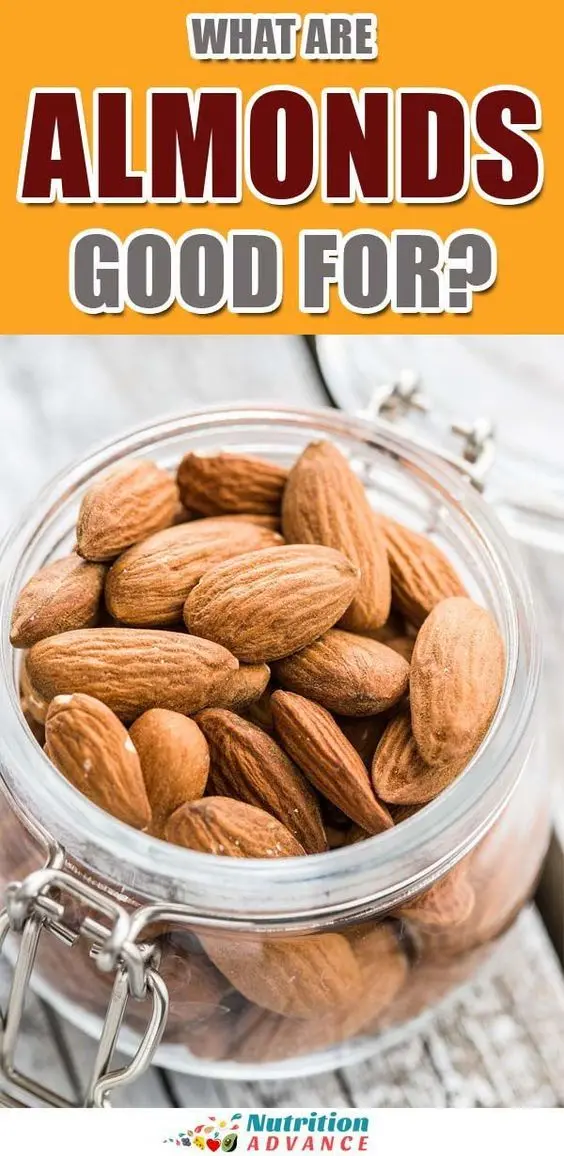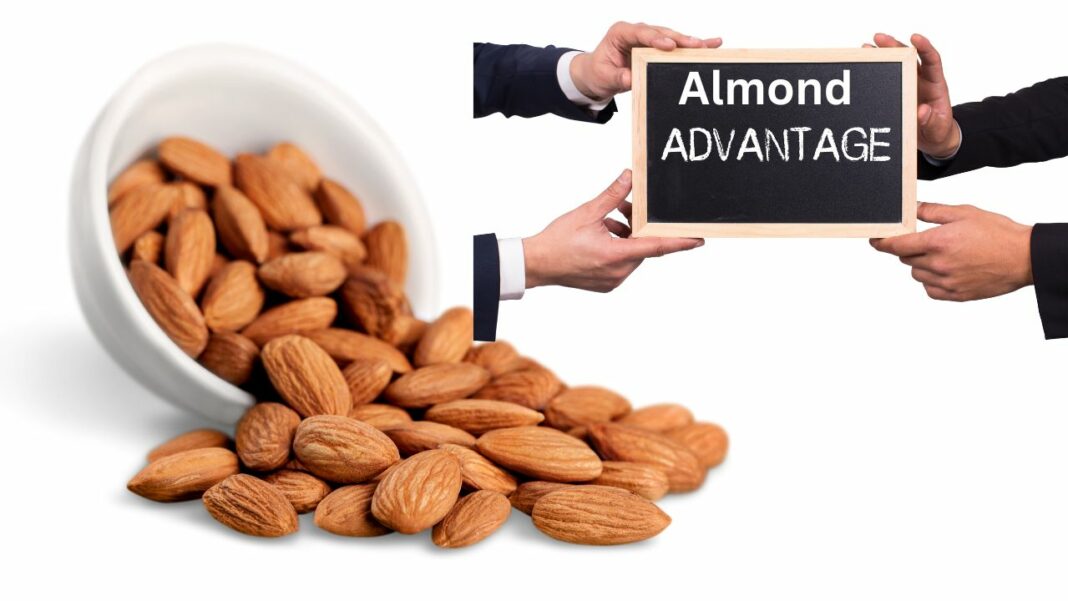
Picture this: you’re standing in the snack aisle of your local store, and there they are – almonds, those little nut-shaped nuggets of goodness. Almonds are like the cool kids of the nut world, and for a good reason!
Welcome to the almond adventure, where we’re going nuts about nuts. In this article, we’ll spill the (nut)beans on almonds, those popular tree nuts that have captured taste buds worldwide.
So, why are we here? Well, we’re on a mission to uncover the secrets of these tiny treats. We’re diving deep into the world of almonds, separating fact from fiction, and helping you make almond-smart choices.
Buckle up because we’re about to explore the almond’s good side and the, well, not-so-good side. We’re diving into the almond’s world, and trust us, it’s a nutty one.
Also Read: The Secret to Digestive Wellness: Almond Snacking
The Two Main Types of Almonds
Sweet Almonds: Nutty Delights
So, let’s meet the star of the nut show: sweet almonds. These little fellas are like the James Bonds of almonds, smooth and classy. They’ve got a slightly nutty flavor, which, honestly, is nut-thing short of amazing. You’ll find them everywhere – supermarkets, almond butter jars, you name it.
What’s the deal with sweet almonds? Well, they’re packed with goodness, and by goodness, we mean nutrients. Think of them as your snack buddies, delivering healthy fats, protein, and even some fiber. It’s like a nutritional party in your mouth!
Bitter Almonds: When Bitter Gets Toxic
Now, let’s talk about their dramatic cousin, bitter almonds. These almonds are like the goth kids of the almond family. They’re not the life of the party; they’re more like the party crashers. Bitter almonds are aptly named because they taste, well, bitterly bitter.
But here’s the kicker: they’ve got a dark secret called amygdalin. When you bite into a bitter almond, this little compound goes, “Surprise!” and transforms into hydrogen cyanide – a not-so-friendly toxin that can be a real party pooper.
The Mutation That Changed the Game
But, wait for it – there’s a twist in the almond tale! A few thousand years ago, Mother Nature played a little prank on bitter almonds. She pulled a genetic switcharoo, turning bitter almonds into sweet ones. How? By making them forget how to make amygdalin. It’s like a superhero origin story, only with almonds.
This genetic switcheroo revolutionized the almond game, leading to the sweet almonds we munch on today. So, the next time you enjoy a handful of sweet almonds, remember that it’s thanks to a tiny twist of fate that they’re not bitter – literally and metaphorically.
Also Read: The Almond Benefits: 10 Reasons to Include Them
Toxicity of Bitter Almonds
Okay, let’s dive into the dark and dangerous world of bitter almonds. Remember that thing called glycoside amygdalin? Well, it’s like the secret weapon of bitter almonds, and it’s not for the faint of heart.
Meet Glycoside Amygdalin: The Silent Assassin
Glycoside amygdalin is the villain of this story, lurking inside bitter almonds. When someone takes a bite of these sneaky nuts, amygdalin says, “Game on!” and starts a chemical transformation.
The Breakdown Drama: So, amygdalin splits into several compounds, and one of them is hydrogen cyanide. Yeah, that’s the stuff used in spy movies to poison enemies. It’s super toxic, folks.
Case Studies: When Bitter Almonds Mean Serious Business
To prove just how dangerous bitter almonds can be, let’s turn to some real-life stories. Case studies suggest that for the average Joe or Jane, munching on 6 to 10 raw bitter almonds is like playing a deadly game of Russian roulette.
And if you’re feeling daring and swallow 50 or more bitter almonds, well, let’s just say you might not live to tell the tale. It’s even riskier for the little ones. Even a smaller number can send them into a cyanide-induced chaos.
Heat to the Rescue?
Now, you might be thinking, “Can’t we just cook these bitter almonds into submission?” Well, it turns out, you can. Heat processing, like baking, microwaving, or boiling, can dramatically reduce the cyanide content. It’s like sending the bad guys to Almond Jail.
- Baking: 79% reduction
- Microwaving: 87% reduction
- Boiling: 98% reduction
But, hold on to your almond hats! We’re not entirely sure how much heat is enough to make bitter almonds safe. So, until the experts give us the green light, it’s probably best to steer clear of these bitter troublemakers.
Also Read: The Art of Soaking Almonds: How It Impacts Your Wellness
Safety of Sweet Almonds
Now that we’ve survived the bitter almond horror story, let’s move on to the heroes of the nut world – sweet almonds. These little guys are like the friendly neighborhood almonds you’ll find in your supermarket.
Amygdalin: The Sweet Almond’s Dirty Little Secret
Guess what? Sweet almonds also have a bit of that amygdalin stuff, but they’re keeping it on the down-low. Their amygdalin content is about 1,000 times lower than those bitter troublemakers. It’s like they’ve taken a vow of non-toxicity.
Sweet Almonds: Your Safe Nutty Friends
The good news is that this tiny bit of amygdalin in sweet almonds is so minuscule that it won’t do any harm. Seriously, you’d have to eat truckloads of them to even think about turning into a cyanide-breathing dragon.
So, in the grand world of almonds, sweet almonds are the ones you can trust. They won’t lead you down a treacherous path of poisoning and despair. Eat them, enjoy them, and let the bitter almonds keep their dangerous secrets.
Sprouted Almonds: Benefits and Risks
Alright, now let’s talk about sprouted almonds. They’re like the rebels of the almond world, trying to break free from their shell and become something greater.
Sprouting: Unlocking Nutrient Superpowers
Sprouting almonds may sound like they’re auditioning for a superhero movie, but it’s all about unlocking their nutrient superpowers. When almonds sprout, their nutrients become more accessible to your body. It’s like they’re saying, “Here, have some vitamins and minerals on the house!”
But Wait, There’s a Catch!
Remember, with great power comes great responsibility. Sprouted almonds are risk-takers. They have a higher chance of getting cozy with harmful bacteria, like Salmonella. So, while they’re busy becoming nutrient ninjas, they might also be plotting some food poisoning mischief.
Pregnant or Vulnerable? Handle with Care
If you’re pregnant or your immune system is not in its A-game, you might want to think twice about befriending sprouted almonds. They can be a tad unpredictable and aren’t the best company for folks in delicate health.
So, if you’re feeling adventurous and want the extra nutrients, go ahead and try sprouted almonds. Just remember, they might come with a side of bacteria.
Also Read: Power of Consistence
Mycotoxins and Mold in Almonds
Ah, nuts and molds – not exactly a dynamic duo like Batman and Robin. But sometimes, they get together, and it’s not a superhero team-up.
Nuts and Molds: An Unwanted Friendship
You see, nuts, including our beloved almonds, can cozy up with toxic molds. It’s like inviting the neighborhood troublemaker to your party. These molds produce mycotoxins, and trust us, you don’t want them as party favors.
Mycotoxins: Tiny Troublemakers
Mycotoxins are like the tiny bullies of the food world. They’re toxic compounds that can mess with your health. Digestive disorders, liver tumors – they’ve got a whole list of party tricks you won’t enjoy.
Raw vs. Roasted: The Mold Showdown
Now, here’s the twist. Raw, unsalted almonds are more likely to have mold issues compared to their roasted and salted buddies. Why? Well, the high temperatures during roasting and the low moisture from the salt make molds feel unwelcome. It’s like telling them, “This party’s invitation-only, and you’re not on the list!”
So, if you’re worried about molds gate-crashing your almond party, go for the roasted or salted ones. They’re like the bouncers keeping the bad guys out.
Regulatory Guidelines
Ever wonder who’s keeping an eye on these moldy almonds? Well, meet the mycotoxin police – the FDA (Food and Drug Administration) and EFSA (European Food Safety Authority). They’ve got some rules for these troublesome molds.
FDA and EFSA: The Mold Monitors
These organizations have set maximum levels of mycotoxins that are considered safe in your snacks. It’s like having a safety net at your party, just in case things get a little too wild.
Check Your Local Party Rules
Now, here’s a twist. The rules may vary depending on where you live. So, before you dive headfirst into a bowl of almonds, be the responsible partygoer and check if your local authorities have their own set of rules. It’s like knowing the local party curfew – you don’t want to be the one causing a ruckus!
So, there you have it – almonds, mycotoxins, and a party with rules. Stay informed, stay safe, and let’s keep the almond party mold-free!
In Crux
Well, folks, it’s time for the grand finale – the almond showdown summary!
We’ve journeyed through the world of almonds, discovering their two main personalities. Sweet almonds are your supermarket darlings, safe and sound for snacking. Bitter almonds, on the other hand, are the wilder cousins, best kept away from your taste buds.
Bitter almonds have a not-so-sweet side – a toxin called glycoside amygdalin that can turn into a cyanide party crasher. It’s like inviting trouble to your snack time soirée. But hey, heat can mellow out their rebellious nature, so you might not want to write them off entirely.
Sweet almonds, however, are the heroes of our story. They’re the ones with low amygdalin content, making them safe for munching. They’re your go-to choice for all things almond, from almond butter to almond milk.
If you’re feeling adventurous and opt for sprouted almonds, remember that there’s a chance of a bacterial plot twist. Pregnant women and immune system warriors, proceed with caution.
Mold can be a sneaky intruder in the world of almonds. It’s less likely to crash the roasted almond party, thanks to those high temperatures. But raw almonds might need a little more scrutiny.
The FDA and EFSA are the mycotoxin police, setting the rules for almond moldiness. But remember, local rules may apply, so keep an eye out for those too.
So, in the almond epic of sweet vs. bitter, safe vs. risky, and mold vs. heat, choose wisely. Keep those almonds safe and sound, and you’re in for a delightful almond affair.
Before we bid adieu to this nutty adventure, here’s a parting tip: If in doubt, roast it out! Roasting can be your trusty sidekick in almond safety.
Now go forth, almond enthusiasts, and enjoy your crunchy, nutritious snack with all the newfound almond wisdom in your arsenal!
Thank you for joining us on this fitness journey! We hope you found our blog insightful and inspiring. Our aim is to provide you with valuable information, expert advice, and motivational content to support you in your wellness endeavors.
Related Post :-
- How To Do Wall Pushups
- Hand Size Demystified
- CrossFit Unleashed
- Barbell Lunges
- Forearm Fortitude
- Kettlebell Circuit
- Power of Personal Trainers
- Down Pull-Ups
FAQs about Almond
Can I eat raw almonds?
When it comes to bitter almonds, it's a hard no. Raw bitter almonds contain a toxin that can break down into cyanide, which is harmful to humans. But fear not, sweet almonds are safe to eat raw and are perfect for snacking or adding to your favorite recipes.
What's the deal with sprouted almonds?
Sprouted almonds have gained popularity for their potential health benefits, like improved nutrient absorption. However, there's a twist – they can be prone to bacterial contamination, especially harmful for pregnant individuals or those with weakened immune systems.
Should I be concerned about mold in almonds?
Mold and almonds are like frenemies. They can coexist, but it's not always pleasant. Raw, unsalted almonds have a higher risk of mold contamination compared to their roasted and salted counterparts. The good news is that regulatory bodies keep a watchful eye on mold levels in almonds.
How can I reduce the risk of almond moldiness?
If you want to minimize the chances of encountering mold in your almond stash, opt for roasted or salted varieties. The heat from roasting helps keep those pesky molds at bay.
What are mycotoxins, and why should I care?
Mycotoxins are toxic substances produced by molds. They can lurk in almonds and pose health risks, including digestive issues and liver problems. Thankfully, authorities like the FDA and EFSA have set safety standards to keep mycotoxin levels in check.
Are there any regulations for almond safety?
Indeed, there are. The FDA and EFSA have established guidelines for mycotoxin levels in almonds to ensure they're safe for consumption. However, it's essential to check for local regulations as well, as they may vary.
Can I eat almond products like almond butter worry-free?
As long as you're dealing with products made from sweet almonds, you're in the clear. Sweet almonds have low amygdalin levels, making them safe for turning into delicious almond butter, milk, or other treats.
Can I trust heat-processed bitter almonds?
While heat processing, such as boiling or roasting, can reduce cyanide content in bitter almonds, it's still wise to exercise caution. More research is needed to determine precisely how much heat is necessary to make them safe.
Any tips for safe almond enjoyment?
Certainly! When in doubt, go for sweet almonds, roasted almonds, or almond-based products. They offer a tasty and safe way to enjoy the goodness of almonds without the bitter or moldy surprises.

Meet Pradeep Singh, your go-to guide for all things fitness, health, and motivation. With over 7 years in the field, Pradeep brings a blend of expertise and real-world experience to his writing. From workout tips to healthy living insights, he simplifies complex topics, making fitness accessible for everyone. His authentic approach and genuine passion aim to inspire and support your wellness journey. Get ready to embark on a path to a healthier lifestyle with Pradeep as your trusted companion and motivator.






















